In Honor Of Julia: Boeuf Bourguignon
You know, I had forgotten how good French food is.
This is because once I got out of culinary school, I can count on one hand how many times I have made French dishes. Oh, yes, I use French technique every day that I enter the kitchen, either at home or in a restaurant, but as for actually making full-on French food–nah, I haven’t done that in years.
Until today.
See, I got all inspired by watching Julie & Julia–all of those porn-worthy shots of delicious looking food got to me and I just -had- to dig out my old dog-eared, butter-stained and battered copy of Mastering the Art of French Cooking and give some recipes a go.
And the first one just had to be Boeuf Bourguignon–not just because it is featured prominently in the film, but because it is one of my favorite French braises. And I hadn’t made it since my first year of culinary school. And I realized that when I was looking at a beautiful pot of it in a red Le Creuset French Oven just like the one that Zak’s Grandma handed down to me, and it was just a shame.
So I had to make it again–and I wanted to use Julia’s recipe and method–just to see how different it was from the version I learned in culinary school.
It was different; in culinary school, I remember tossing the meat with flour and then browning it in rendered bacon fat and olive oil. The meat was then removed, and onions and carrots were browned in the same oil, while scraping up bits of browned flour from the bottom of the pan.
Julia’s recipe calls for the meat to simply by dried with a paper towel and then put into the pan with the nearly bacon fat and oil and browned well on all sides. Then the meat is removed and set aside, and the onions and carrots are browned in the pan. Then the onions and carrots are removed, and the cooking fat is poured out of the pan. Back into the pan goes the beef, bacon lardons, onions, and carrots. At this time, the flour is sprinkled over the meat and it is tossed together so the meat is coated lightly with flour.
Then into the a 450 degree F. oven the pan goes for four minutes. After four minutes, you take the pan out, toss everything around again, and pop it back in for another four minutes and when it comes out, the meat has a kind of crusty crisp coating of browned flour and there are bits of browned flour goodness all over the onions and carrots. The oven got turned down to a nice moderate temperature–325 degrees F.
In to the pot goes the wine–I used Cabernet Sauvignon–a nice dry and robust one I had around–and beef stock or broth, some tomato paste, minced garlic (Julia crushes hers, but I like more garlic flavor, so mine got minced), thyme, a bay leaf and some salt and pepper. Everything got a nice stir, the liquid was brought to a simmer on the stovetop, then the lid was clapped on and into the oven it went, there to cook, pretty well unattended (I did check on it twice) for about three hours.
Now, I ask you–how hard is that, really?
And the technique of sprinkling the flour on -after- the meat is browned–I really like the texture it gave the beef, and I also like the fact that it made a nice thick, smooth sauce by the end of the cooking time with minimal effort from me.
So, for the first two hours that the beef cooked, I went into my sewing room and worked on a quilt. I didn’t need to be in the kitchen, hanging over the stove, waiting for the beef to do its thing. It was fine all on its own. That is the beauty of making a braised dish in an enameled cast iron pot in the oven–you don’t need to hover. It does all the work for you.
So, I waited for the last hour of the cooking time to make the brown braised pearl onions and butter sauteed mushrooms. I had forgotten how simply cooked both of these absolutely fabulous vegetables are, but simple doesn’t mean flavorless. Oh, no–these tasted amazingly good.
The onions are simple–you peel them–easily the most annoying step in the making of this dish. I do it the way I learned at my very first restaurant job–cut a tiny slice off the top and bottom of the onion, and then make a shallow slit from top to bottom that cuts through just the first layer of onion skin and flesh. Then peel that layer off and voila! You have a pretty, shiny pearly onion, all ready to get browned in butter and olive oil, then braised in a bit of wine and beef stock.
When they are done, they are even prettier than they were all shiny and new and white. They are brown and delectable; the liquid they are cooked in reduces to a thick, deeply colored and flavored glaze that coats those dear little alliums in a cloak of sweet, meaty goodness.
I made an extra couple of onions and it was a good thing–because once I tasted one, I had to give on to Brittney to try. But then, maybe if we hadn’ t tasted them in the first place, we would not have tortured ourselves to keep from eating the rest before everything else was done.
So, we contented ourselves with licking the thick syrupy bits of leftover glaze that clung to the sides and bottom of the saucepan.
The mushrooms are simplicity incarnate. You wash them, you dry them and you cut the bottom edge of the stem off. Then you either leave them whole or cut them into quarters–I decided to cut mine up–and you saute them in butter–in small quantities–never crowd your mushrooms in the pan or they will steam instead of saute–and that is it. I did mine in two batches and got the brownest lightly crisped on the edges mushrooms you could ever want.
Boiled potatoes are a traditional side for this dish, so I did whole small Carolas and French Fingerlings boiled in their jackets until done. Then, I drained them and popped them into a saute pan that had melted, bubbling butter in it, and sprinkled them with salt, pepper and minced fresh rosemary and tossed them around over high heat for about five minutes. The butter browned lightly and coated the potatoes in a delicious golden glaze that made them shimmer, flavored with those lovely deep green flecks of rosemary leaves. The rosemary really highlighted the natural nutty flavor and smooth texture of these little potatoes, while not interfering with the sauce from the beef.
Then, I just made a simple green salad with a honey-Dijon vinaigrette, and cut into a baguette, and strained the sauce from the beef–which had attended to itself so perfectly that I didn’t even have to reduce it any farther in order to get it to gently coat the back of a spoon.
And dinner was served.
Now, here are a few caveats–I did take a few shortcuts and made a few tiny changes to Julia’s recipe–mostly having to do with the bacon. I didn’t have bacon that hadn’t already been sliced, though I had some that had been quite thickly sliced, so I used that. And I didn’t blanch the bacon, because I saw no really good reason to do so.
And, when it came time to put the meat back into the pot before pouring the strained sauce over it–I had forgotten to pick the bacon out of the tangled mess of spent onion and carrot corpses and put it back in with the beef, so we ate it sans bacon. But, you know–it still tasted damned fine anyway, so I don’t feel all that bad about it.
And one more thing–here is a tip directly from me, not Julia, about what to do if your perfectly sublime sauce turns out to taste just a little flat. If adding salt and pepper to taste rounds it a bit, but not quite enough–give it a little dash of balsamic vinegar. No really–it will perk up any sauce or gravy that might be just a bit too rich to taste right–the taste will flatten out sometimes. The vinegar rounds it back out and gives it sparkle. I am talking just a little bit–not much–a half teaspoon to a teaspoon at most, and sometimes even less than that. Be sparing!
Looking back on tonight’s dinner, I’m not really sure how or why I forgot how good French food is–but I don’t intend to make that mistake again.
Now I just have to figure out which recipe to turn to next in Julia and Simone Beck’s magnum opus.
Boeuf Bourguignon
Ingredients:
6 ounces thickly sliced bacon cut into 1/2″ wide pieces down the length of the bacon slices
1 tablespoon olive oil
3 pounds fairly lean stewing beef, cut into 2″ cubes (I used half top round and half chuck, well trimmed of fat)
1 large peeled and sliced carrot
1 large sliced onion
1 teaspoon salt
1/2 teaspoon freshly ground black pepper
2 tablespoons all purpose flour
3 cups of full-bodied red wine (I used Cabernet Sauvignon, as I noted earlier)
2-3 cups beef stock or broth
1 tablespoon tomato paste (I use the kind that comes in tubes like toothpaste–so convenient!)
2 large cloves garlic, minced (mine worked out to be about a tablespoon and a half after it was minced–big cloves of garlic!)
1/2 teaspoon thyme
1 bay leaf, crumbled
18 pearl onions, peeled
1 1/2 tablespoons butter
1 1/2 tablespoons olive oil
1/4 cup red wine (from the same bottle as the wine for the beef!)
1/2 cup beef stock or broth
1/2 teaspoon dried thyme
salt and pepper to taste
2 tablespoons butter
1 tablespoon oil
1/2 pound fresh mushrooms, washed, dried and trimmed–if small, leave whole, if larger, quarter
salt and pepper to taste
a tiny amount of balsamic vinegar–if needed*
fresh thyme leaves and chopped fresh parsley leaves for garnish
Method:
Preheat your oven to 450 degrees F.
Heat the first measure of olive oil in a heavy-bottomed skillet over moderate heat. Cook the bacon until it is just starting to brown and is nicely brown, but is not crisp. Remove from skillet and set aside on a plate. Turn the heat up to high and let the oil and rendered bacon fat come nearly to the smoke point.
Dry the cubes of beef well on paper towels–remember if the meat is not dry, it will not make a nice browned crust. Brown it on all sides in the same skillet in which you cooked the bacon. Do it in batches if you have to–don’t crowd the pan or the meat will not brown as nicely.
When the beef is brown all around, remove it and set it aside on the plate with the bacon.
Dump the sliced onion and carrot into the same skillet and sprinkle with the salt and pepper, then cook, stirring, until the onions brown really well–they should be a reddish color, and the carrots are browned at the edges. Scoop the vegetables out with a wire skimmer and put them with the meat. Dump out the cooking oil.
Put the beef, bacon, onions and carrots into a heavy bottomed Dutch oven or deep casserole dish. Sprinkle the flour over everything and toss the meat especially to coat it well.
Pop it uncovered into the oven for exactly four minutes. Take it out and stir it well making sure to turn the meat, and put it back in for another four minutes.
Take it out and turn the oven temperature down to 325 degrees F.
Stir in the wine and enough stock or broth to make sure that the beef cubes are just barely covered. You can have wee bits and corners of the cubes poking out–but you don’t want huge swaths of meat uncovered–you don’t want it to dry out. Stir in the garlic, the tomato paste, the bay leaf and the thyme, then turn the heat on under the pot and bring the liquid to a nice easy simmer.
Clap the lid on the pot and into the oven it goes. Check it now and again to make sure it is simmering, not boiling and that the liquid level is not reducing too quickly. Otherwise, you can leave the pot pretty well undisturbed.
While the beef cooks, prepare the onions: Melt the butter and olive oil measures that come in the list right under the pearl onions in a skillet or wide saucepan. Add the onions, and cook, tossing and stirring and rolling the onions gently around until they are as evenly browned as you can manage–they won’t be perfect because these little rascals just roll back and forth and won’t keep enough to get an even tan.
When they are a nice golden color flecked with some pale white shimmer showing, pour in the wine and stock or broth and add the thyme.
Bring to a simmer over high heat, turn the heat down and cover the saucepan and cook, stirring as needed, until the onions are mostly tender. Remove the lid from the pot and cook, shaking and stirring until the liquid reduces down to nothing more than a shiny deep reddish brown glaze that clings mostly to the onions, but a bit to the pot. Add salt and pepper to taste to the onions, toss them once or twice more to distribute the salt and pepper, and set aside to be added to the beef at the last moment before service.
Once the onions are done–make the mushrooms.
Melt the last measure of butter with the last measure of olive oil in a saute pan. Put half of the mushrooms in the pan, and cook, stirring and tossing, until the mushrooms take on a deep golden hue with lightly crispy browned edges. Pour the cooked mushrooms into the same bowl as the onions and cook the second batch the same way. Set them aside with the pearl onions.
The beef is finished cooking when a fork with easily pierce it and just as easily slide out again. If the beef clings to the fork, even if the fork went in easily, the meat still need to cook some more. But when it is ready, remove the beef from the cooking pot and set it aside with the pearl onions and mushrooms. If you want to go fishing around for the pieces of bacon, by all means, do so, but I didn’t bother and the dish was still fantastic.
Then place a fine sieve over a saucepan and scoop the liquid and remaining solids out of the cooking pot into the sieve. Press the solids against the sieve to remove as much liquid from them as possible–the sauce is thick and will cling to the solids. What I did was ladle the contents of the pot one or two ladlesful at a time into the sieve, and then I was mash and stir the stuff in the sieve against it and let all of the sauce be pushed or drip out, then I would empty the solids from the sieve for the compost bucket, though if I still had dogs, I would have given the solids to them–they would have loved it. Then, I repeated until I had the pot emptied and the sauce all collected.
Then, scrub out your cooking pot, and dry it well. Put the beef, pearl onions and mushrooms into it.
Heat the sauce in the saucepan over medium heat until it simmers. If it is thick enough to lightly coat the back of a spoon, you are golden and have to do very little. If it is too thick, thin it out with a tiny bit of broth–if it is too thin, bring the sauce to a boil and reduce it to the proper thickness. If you defatted your beef and poured out the oil well, you will have very little to no excess fat in the sauce, but if you do, and some comes to the top as you simmer it, skim it off and discard it. You should end up with about two and a half cups of really delicious sauce. Taste your sauce and add salt and pepper as needed–and a tiny dash of balsamic vinegar if it is properly salted and peppered, but still tastes just a little bit flat.
When the sauce is the proper thickness, pour it over the meat and vegetables and give it a nice stir to coat everything, and then sprinkle with the fresh herbs and either keep it warm in its pot–this is why cast iron enameled pots are so great–or serve it right away, with a salad, some boiled potatoes and some good baguette to sop up the sauce.
9 Comments
RSS feed for comments on this post.
Sorry, the comment form is closed at this time.
Powered by WordPress. Graphics by Zak Kramer.
Design update by Daniel Trout.
Entries and comments feeds.

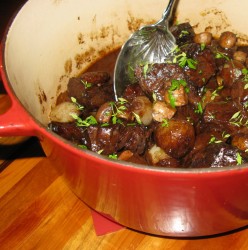
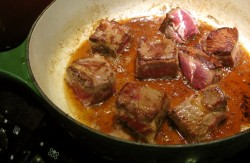
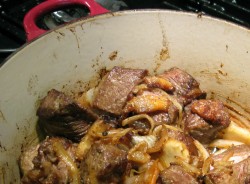
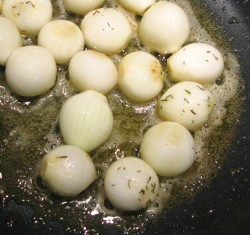
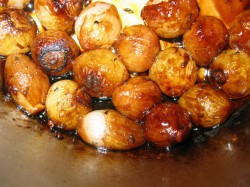
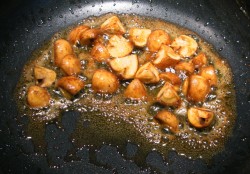
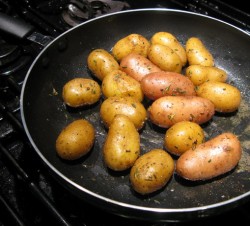
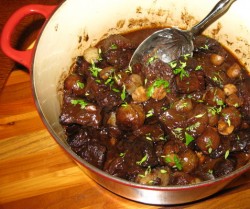


Re rounding out a sauce, I’ve heard the same thing about a dash of fish sauce. I’ve never tried it but the info is stored away in case I need it.
Comment by Stephanie — August 30, 2009 #
I’ve done the fish sauce trick in other dishes—it works like a charm. It is the concentrated umami that is in it that works.
With balsamic, it is a combination of acid and umami–so it gives a sauce a one-two punch of flavor.
Comment by Barbara — August 30, 2009 #
Oof. You make it sound easy.
I make beef bourguignon and coq au vin often, but I take shortcuts… maybe some day I should follow this recipe to the T.
And +1 on the fish sauce thing.
Comment by Wouter — August 31, 2009 #
I live on boeuf bourguignon over the winter, albeit not La Julia’s recipe. It is quite possibly the ur-comfort food!
Comment by Elizabeth Yalkut — August 31, 2009 #
I make a slow-cooker version of this that I really love. I use the slow-cooker so that I can make it early in the day and let it go when I’m not going to be home. The method is almost exactly the same as outlined in MtAoFC, but instead of making a roux, I use quick-cooking tapioca. Roux thickened sauces often don’t turn out well in a slow-cooker, but tapioca makes a sauce that is lush, thick, and glossy. After the meat and vegetables are browned and added to the slow cooker, the wine and stock are added, and about 3 TBS of tapioca is sprinkled on top. Clamp the lid on and let it go for at least 6 hours, but no more than 8. Right before service, I carmelize my onions (I use frozen pearl onions, they work just fine and save me a ton of time peeling tiny onions) and mushrooms. I stir fresh minced parsley into the stew, and fold in the onions and mushrooms. I like to serve it with either pan-fried yukon golds or buttered egg noodles.
This is one of my favorite crappy, cold weather dishes! I made this for Christmas Eve last year, and it was a big hit.
Comment by Roxanne — September 6, 2009 #
Forgot to add that I do deglaze the pan that I browned the meat and vegetables with the wine before adding it to the slow-cooker.
Comment by Roxanne — September 6, 2009 #
I enjoyed your play by play of making Boeuf Bourguignon. Inspired by the movie, I found the last copy of MAFC at Barnes and Noble and I spent all day yesterday making it but was disappointed by the results. The sauce tasted to “winy” so I’ll try the balsamic tonight with the leftovers. Also, my meat was too grainy after the 2 3/4 hours cooking.. When chewed, it was mushy, not sinewy like meat should be. Should I have just asked for stew meat? (I read somewhere that when you buy precut meat you don’t know what you’re getting… I used some kind of steak that the butcher recommended, but I wish I’d chosen a tougher meat.)
PS: the onions were the best part.
Comment by Katy — September 7, 2009 #
Oh, goodness, Katy–never use steak for this recipe. It isn’t your fault–the butcher suggested it, but steak is way too tender a cut to be braised like this, certainly not for 2 1/2 hours!
I use chuck and top round roasts for this, and cut them up myself into chunks much larger than your standard stew meat–which is usually chuck, btw, but it also contains various trimmings as well.
Also, next time, try and use use slightly more broth or stock than wine, or use a softer-flavored wine than you used the first time.
And yes–after you reduce the wine sauce at the end, taste and correct the seasoning with some salt and pepper. Then, tastes, and if it needs a dab of “oomph,” add a little bit of balsamic, and taste it again. That usually does it. If not, add a teaspoon of butter and stir it in, and see what happens. One last remedy–either an 1/8th teaspoon of anchovy paste or a teaspoon or two of Thai fish sauce will do the trick if the balsamic and butter don’t.
Comment by Barbara — September 7, 2009 #
O, Barbara! Scrumptious.
Thank you for the hot tip on the potatoes.
Comment by Desert Verdin — September 22, 2009 #